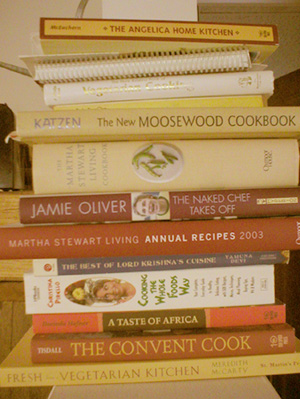RECIPES
The Art of Collecting Cookbooks

Cookbooks
In my quest for collecting cookbooks, I already have 250 titles. Not much of a promising feat but maybe when I reach the age of 50, I could have a thousand at least.
I had my first cookbook during second year high school. It's the Good Food Cookbook, in full-color and contains simple instructions.
When I have time, I always look in the library's Home Economics Section where one could find old cookbooks. This went on even when I was in college and joined my first ever competition. Half of my prize was spent on cookbooks at National Bookstore during a sale where I bought the items at half the price.
My passion for collecting cookbooks was originally meant to be a collection. If you're passionate about something, you don't aim for quantity but quality. Then, you realize you have enough. Being a collector does not mean having hundreds of such items, but must enjoy what you are doing.
When I was working in the hotel, I told my colleagues, friends and staff that I wouldn't mind if they give me a second-hand cookbook for a gift. I always imagined my desk filled with books, thus whenever I got my salary, I buy at least one book. Then, I would wait for my bonus or salary adjustment to purchase my dream cookbook.
My hotel room was transformed into a mini library. My staff would go there and research on the recent trends.
Here are some of the general cookbook classifications you could follow when starting your book collection. Cookbooks are divided into several categories: Type of Cuisine, Specialty Courses, Artisanal Cookbooks and Fundamental Cookbooks.
The Cuisine Type Cookbook is focused on a specific country's cuisine --- Spanish, Italian, French or Filipino. Some of the ingredients in these books are not locally available but you could apply alternatives. One that has colored photographs is better so you could have a comparison with what you cooked.
Specialty Courses focus on key areas of cooking like All Salad Recipes or the Pasta and Pizza Book, Purely Fish or Succulent Meats. These are specialty cookbooks that focus on one main ingredient or method of preparation like the Williams and Sonoma Line of Cookbooks. They focus on the cooking methods --- Grill, Saute and Boiling, among others. But as a cookbook collector, I don't personally prefer a collection series because it's quite frustrating if a certain edition has run out of print.
Artisanal Cookbooks are cookbooks written by chefs. These are the most expensive. A three-piece collection by Fernan Adria of El Bulli, Spain costs P14,000. His is hailed by food critiques as the best restaurant on the planet. True enough, you need to reserve two years earlier before you could eat in his restaurant. This is due to the fact that he's closed for six months every year so he could perfect his techniques. He opens only during spring and summer.
My latest acquisitions are Thomas Keller for the French Laundry and Manila's Best Kept Restaurant Secrets. The latter is a very good coffee table book that features the best restaurant listing in Manila. This is my guide everytime a client asks me which place is good to dine at.
Fundamental Cookbooks are those made by top culinary schools like the Culinary Institute of America or the Le Cordon Bleu. Both seem the same although the latter is more inclined to the French Classical Tecniques. The CIA book dwells on the technical aspect or the scientific approach to cooking. Both are less than P5,000 pesos each. When I got mine in year 2000 it cost P3,500 per book. They're the more expensive ones because they're so thick and not mass produced.
You only need to purchase one title that could help you in culinary terms and techniques in case you want to pursue professional cooking.
In my quest for collecting cookbooks, I already have 250 titles. Not much of a promising feat but maybe when I reach the age of 50, I could have a thousand at least.
The important thing is to enjoy and learn from these pieces of knowledge, get inspiration from and develop your own culinary style. If you want to concentrate on one area, it's fine. Just enjoy reading. Until next time. Ciao!
